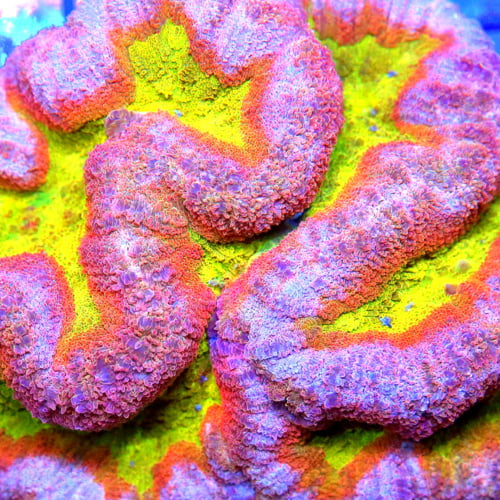Extreme Corals News and Updates
Coral Health Indicators: How to Tell if Your Coral is Thriving or Stressed
Discover How Coral Microbiomes Drive Growth, Immunity, and Color in Your Reef Tank
Explore the fascinating coral microbiome, focusing on the role of beneficial bacteria and algae. This blog explains how these microscopic partners drive coral growth, support immunity, and boost coloration in your reef tank, ensuring a healthy coral ecosystem.
by Test test • February 07, 2025
The Art of Reading Your Corals
Corals may not communicate like fish or other tank inhabitants, but they have their own language. Through changes in color, behavior, and polyp extension, corals reveal their health and whether they're thriving or stressed. Learning to interpret these coral health indicators is vital for reef keepers, enabling you to address problems early and maintain a vibrant reef ecosystem.
In this guide, we’ll explore the signs of healthy and stressed corals, their potential causes, and actionable tips for ensuring your corals flourish.
What Does a Healthy Coral Look Like?
Healthy corals exhibit specific characteristics that signal their well-being:
- Vivid Colors: Vibrant, rich colors often indicate a coral is thriving. The pigments come from zooxanthellae algae and other natural compounds, which are abundant in healthy coral tissue.
- Polyp Extension: Fully extended polyps are a sign that the coral is feeding and interacting with its environment. Polyp movement in the current is an excellent indicator of adequate water flow.
- Growth and Spread: Healthy corals grow steadily, developing new branches, polyps, or encrusting onto nearby surfaces.
- Stable Attachment: Thriving corals remain securely attached to their base, with no signs of tissue detachment.
When your coral displays these traits, it’s a clear indication that the environment is meeting its needs.
Recognizing Signs of Coral Stress
Stress in corals can be caused by a variety of factors, including poor water conditions, inadequate lighting, or competition with neighboring species. Here are the reef tank stress signs to watch for:
Fading or Discoloration
When corals lose their vibrant hues, it’s often due to a decrease in the density of zooxanthellae algae. Common causes include insufficient lighting, poor water quality, or stress from temperature fluctuations. Bleaching is an extreme form of discoloration where corals expel zooxanthellae, leaving them pale or white.
Lack of Polyp Extension
If polyps are retracted or closed for extended periods, it may indicate stress. This behavior could result from changes in water flow, aggressive neighbors, or poor lighting. Persistent retraction suggests a need to assess the tank’s environment.
Tissue Recession or Detachment
When coral tissue begins pulling away from the skeleton, it’s a serious sign of stress. This condition, often caused by poor water conditions or bacterial infections, requires immediate attention.
Slow or No Growth
Corals that stop growing may be experiencing stress due to insufficient nutrients, overcrowding, or imbalanced water parameters. A plateau in growth is often a sign that environmental conditions need to be optimized.
Presence of Algae or Pests
Corals struggling with algae overgrowth or pest infestations may appear dull or unhealthy. Issues like flatworms, nudibranchs, or invasive algae can overwhelm stressed corals, further impacting their health.
Common Causes of Coral Stress
Understanding what causes coral stress is the first step toward solving it. Here are some of the most common culprits:
- Water Quality Issues: Fluctuations in temperature, salinity, pH, or nutrient levels can cause stress. Corals are especially sensitive to nitrate and phosphate imbalances.
- Lighting Problems: Insufficient or excessive light can harm zooxanthellae, the algae that provide nutrients to corals.
- Inadequate Water Flow: Proper flow ensures nutrient delivery and waste removal. Low flow can cause buildup of detritus, while overly strong currents may damage delicate polyps.
- Aggressive Neighbors: Coral species with stinging tentacles or chemical defenses can harm nearby corals, causing stress and tissue damage.
Tips for Promoting Coral Health
Keeping corals healthy requires consistent monitoring and proactive care. Here are some coral care tips to ensure your reef remains vibrant:
Maintain Stable Water Parameters
Consistency is key in reef tanks. Monitor temperature, pH, salinity, and nutrient levels regularly. Keep your water temperature between 72°F and 78°F and salinity at 1.024–1.026 specific gravity. Use reliable test kits to track nitrate and phosphate levels, as excessive nutrients can encourage algae growth.
Provide Appropriate Lighting
Different corals have varying light requirements. Research the needs of each species and adjust your tank’s lighting spectrum and intensity accordingly. Invest in quality LED systems with adjustable settings to simulate natural light conditions.
Ensure Proper Water Flow
Tailor water flow to the needs of your corals. SPS corals thrive in strong, turbulent currents, while LPS and soft corals often prefer moderate flow. Use adjustable powerheads to create varied flow zones within your tank.
Feed Your Corals
While zooxanthellae provide energy through photosynthesis, supplemental feeding helps corals grow and maintain vibrant colors. Use high-quality coral foods, such as phytoplankton or amino acid blends, to meet their nutritional needs.
Quarantine New Additions
Introducing new corals or fish without quarantine can introduce pests and diseases to your tank. Quarantine new additions for at least two weeks to prevent potential contamination.
Watch Your Corals Closely
Recognizing coral health indicators and understanding how to address stress are essential skills for any reef hobbyist. By observing changes in color, polyp behavior, and growth patterns, you can spot early warning signs and take corrective action before issues escalate.
Healthy corals not only add beauty to your reef tank but also contribute to a balanced ecosystem. With careful attention to water quality, lighting, flow, and feeding, you’ll create an environment where your corals can thrive and flourish.
Start tuning in to what your corals are telling you—they’re the best indicators of your reef’s health!

